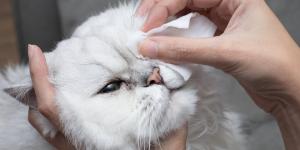My Dog's Third Eyelid Won't Retract - Third Eyelid Prolapse in Dogs



See files for Dogs
The prolapse of a dog's third eyelid refers to the elevation of the smooth inner eyelid that is located between the cornea and the inside corner of their eyelids. This occurs due to a weakness of the connective tissues that hold the gland in place.
Therefore, if you notice that your dog has a red lump in their eye, they're squinting a lot or that their third eyelid won't retract, this is the article for you. In this AnimalWised article, we're going to talk about the third eyelid prolapse in dogs. We'll go through the symptoms, causes, diagnosis and treatment. Keep reading to learn more!
What is third eyelid gland prolapse in dogs?
Dogs have three eyelids. The third eyelid gland is an extra eyelid that sweeps back and forth across the surface of the eye providing protection and spreading the tear film. It usually hides within their inner eyelid closest to the nose.
However, if a dog suffers from protrusion or prolapse of their third eyelid, their third eyelid will be visible on the inner corner of their eyes. It will look like a red lump.
Therefore, the prolapse of a dog's third eyelid refers to the elevation of the smooth inner eyelid that is located between the cornea and the inside corner of their eyelids. This occurs due to a weakness of the connective tissues that hold the gland in place.

Causes of third eyelid relapse in dogs
There are many causes of third eyelid relapse in dogs, the main causes are the following:
- Genetics
- Abnormally small eyes
- Shrinkage of eyeballs due to long-time chronic disease
- Any eye health problem, such as entropion
- Tumours, cysts or inflammation in the eye
- Any cause of setting the eye deeper in the socket
- Weakening of the gland of the third eyelid
- Relaxation of the muscles around the eyeball
- Decreased or loss of function of the nerve supple around the eyeball
- Neurologic causes, such as Horner's syndrome, tetanus or dysautonomia
- Damage to cranial nerves
- Tranquilization of nerves due to medication
Lastly, some breeds are more prone to this eye problem than others. They are Cocker Spaniels, Beagles, Chihuahuas, Mastiffs and brachycephalic breeds (such as Bulldogs, Terriers, Pugs).
Symptoms of third eyelid prolapse in dogs
Certain symptoms of prolapse of the third eyelid in dogs are similar to other eye problems. Nevertheless, the most common symptom is being able to see their pink or red gland coming from the inner corner of their eye. This eyelid is normally not visible when dogs have their eyes open, therefore, if you can see it popping out, it's time to take your dog to the veterinarian.
With that being said, other symptoms include:
- Inflammation in the eye
- Abnormal appearance of the red gland in the inner corner of their eye/s
- Squinting or narrow eyes
- Any abnormal changes in their eyes
These symptoms can occur in one or both eyes. If you see your dog experiencing any of these symptoms or any other abnormal behaviour, it's very important to take them to the veterinarian to be properly diagnosed and treated as soon as possible.

Dianosing a dog with third eyelid prolapse
This condition is typically diagnosed with a full ophthalmic examination assessing the typical clinical signs, such as the red lump in their inner eye. However, your veterinarian may also carry out other examinations, such as:
- Complete medical history and physical examination
- Third eyelid itself with a forceps (after applying anesthesia)
- Neurologic examination
- Blood tests
- Skull X-ray to determine the presence of a bony orbital
- Ultra sound examination of the eye and soft issues around eye
- Specialized imaging tests such as a CT or MRI
Only your veterinarian can know what examination will help determine the cause of your dog's condition. The best thing is to take your dog to them as soon as you notice a symptom and allow them to properly examine, diagnose them and find the best treatment.
Treating third eyelid prolapse in dogs
The only treatment for third eyelid prolapse in dogs is surgery. The surgery is based on repositioning the gland, however, this disease can reoccur. This is especially common in brachycephalic dog breeds, such as bulldogs and pugs.
Surgical success rate is 90%, and the healing time from surgery is 3-6 weeks. Eye medications will be continued for several weeks to decrease pre-existing inflammation of the conjunctiva and gland.
It's important to note that the treatment will depend on your dog's breed, age, condition, etc. Your veterinarian will thoroughly examine your dog in order to properly diagnose them and find the best treatment for their condition.
We leave you this video where you can see what a prolapse in a dog's third eyelid looks like when their eyes are relaxed.

This article is purely informative. AnimalWised does not have the authority to prescribe any veterinary treatment or create a diagnosis. We invite you to take your pet to the veterinarian if they are suffering from any condition or pain.
If you want to read similar articles to My Dog's Third Eyelid Won't Retract - Third Eyelid Prolapse in Dogs, we recommend you visit our Eye problems category.







